What Do We Learn from Good Practices of Biologically Inspired Design in Innovation?
Abstract
:1. Introduction
Biologically Inspired Design in Innovation
- to develop new products, as seen for example with the development of artificial attachment devices based on the dry adhesion of the gecko [36],
- or to transpose a scientific discovery to an application, as seen with the self-cleaning properties of the lotus plant, which also led to a true paradigm shift [21].
2. Materials and Methods
3. Results and Discussion
3.1. Innovation and Commercialization Process / Steps Toward Commercialization
3.2. Challenges of the Process and Barriers to Market Entry
4. Conclusions
- implementing BID in product development,
- facilitating commercialization, and
- supporting existing and new industries (start-up community).
Author Contributions
Funding
Acknowledgments
Conflicts of Interest
References
- Lepora, N.F.; Verschure, P.; Prescott, T.J. The state of the art in biomimetics. Bioinspir. Biomim. 2013, 8, 013001. [Google Scholar] [CrossRef] [PubMed]
- von Gleich, A. (Ed.) Potentials and Trends in Biomimetics; Springer: Heidelberg, Germany, 2010; ISBN 978-3-642-05246-0. [Google Scholar]
- Vincent, J.F.V. Biomimetics—A review. Proc. Inst. Mech. Eng. Part H J. Eng. Med. 2009, 223, 919–939. [Google Scholar] [CrossRef] [PubMed]
- Ferdinand, J.-P.; Petschow, U.; von von Gleich, A.; Seipold, P. (Eds.) Literaturstudie Bionik: Analyse Aktueller Entwicklungen und Tendenzen im Bereich der Wirtschaftsbionik; Schriftenreihe des IÖW: Berlin, Germany, 2012; ISBN 978-3-940920-04-1. [Google Scholar]
- ISO/TC 266—Biomimetics; ISO 18458:2015; International Organization for Standardization: Geneva, Switzerland, 2015.
- Goel, A.K.; McAdams, D.A.; Stone, R.B. (Eds.) Biologically Inspired Design: Computational Methods and Tools; Springer: London, UK; New York, NY, USA, 2014; ISBN 978-1-4471-5247-7. [Google Scholar]
- Lenau, T.A.; Metze, A.-L.; Hesselberg, T. Paradigms for Biologically Inspired Design. Proc. SPIE 2018. [Google Scholar] [CrossRef]
- Speck, O.; Speck, D.; Horn, R.; Gantner, J.; Sedlbauer, K.P. Biomimetic bio-inspired biomorph sustainable? An attempt to classify and clarify biology-derived technical developments. Bioinspir. Biomim. 2017, 12, 011004. [Google Scholar] [CrossRef] [PubMed]
- Zollfrank, C.; Scheibel, T.; Seitz, H.; Travitzky, N. Bioinspired Materials Engineering. In Ullmann’s Encyclopedia of Industrial Chemistry; Wiley-VCH Verlag GmbH & Co. KGaA, Ed.; Wiley-VCH Verlag GmbH & Co. KGaA: Weinheim, Germany, 2014; pp. 1–22. ISBN 978-3-527-30673-2. [Google Scholar]
- Benyus, J.M. Biomimicry: Innovation Inspired by Nature; Repr.; Harper Perennial: New York, NY, USA, 2008; ISBN 978-0-06-053322-9. [Google Scholar]
- Fayemi, P.E.; Wanieck, K.; Zollfrank, C.; Maranzana, N.; Aoussat, A. Biomimetics: Process, tools and practice. Bioinspir. Biomim. 2017, 12, 011002. [Google Scholar] [CrossRef] [PubMed]
- Mayser, M.J.; Bohn, H.F.; Reker, M.; Barthlott, W. Measuring air layer volumes retained by submerged floating-ferns Salvinia and biomimetic superhydrophobic surfaces. Beilstein J. Nanotechnol. 2014, 5, 812–821. [Google Scholar] [CrossRef] [PubMed]
- Helfman Cohen, Y.; Reich, Y. Biomimetic Design Method for Innovation and Sustainability; Springer: Cham, Switzerland, 2016; ISBN 978-3-319-33996-2. [Google Scholar]
- Antony, F.; Grießhammer, R.; Speck, T.; Speck, O. Sustainability assessment of a lightweight biomimetic ceiling structure. Bioinspir. Biomim. 2014, 9, 016013. [Google Scholar] [CrossRef] [PubMed]
- Antony, F.; Grießhammer, R.; Speck, T.; Speck, O. The cleaner, the greener? Product sustainability assessment of the biomimetic façade paint Lotusan® in comparison to the conventional façade paint Jumbosil®. Beilstein J. Nanotechnol. 2016, 7, 2100–2115. [Google Scholar] [CrossRef] [PubMed]
- Fish, F.E.; Beneski, J.T. Evolution and Bio-Inspired Design: Natural Limitations. In Biologically Inspired Design; Goel, A.K., McAdams, D.A., Stone, R.B., Eds.; Springer: London, UK, 2014; pp. 287–312. ISBN 978-1-4471-5247-7. [Google Scholar]
- Wanieck, K.; Fayemi, P.-E.; Maranzana, N.; Zollfrank, C.; Jacobs, S. Biomimetics and its tools. Bioinspir. Biomater. Biomater. 2017, 6, 53–66. [Google Scholar] [CrossRef]
- VELCRO® Brand Fasteners and Hook and Loop. Available online: https://www.velcro.com/ (accessed on 24 September 2018).
- Sharklet Technologies, Inc. Available online: https://www.sharklet.com/ (accessed on 24 September 2018).
- Vincent, J.F.V.; Bogatyreva, O.A.; Bogatyrev, N.R.; Bowyer, A.; Pahl, A.-K. Biomimetics: its practice and theory. J. R. Soc. Interface 2006, 3, 471–482. [Google Scholar] [CrossRef]
- Barthlott, W.; Neinhuis, C. Purity of the sacred lotus, or escape from contamination in biological surfaces. Planta 1997, 202, 1–8. [Google Scholar] [CrossRef]
- Jacobs, S.R.; Nichol, E.C.; Helms, M.E. “Where Are We Now and Where Are We Going?” The BioM Innovation Database. J. Mech. Des. 2014, 136, 111101. [Google Scholar] [CrossRef]
- Snell-Rood, E. Interdisciplinarity: Bring biologists into biomimetics. Nature 2016, 529, 277–278. [Google Scholar] [CrossRef] [PubMed]
- Yen, J.; Helms, M.; Goel, A.; Tovey, C.; Weissburg, M. Adaptive Evolution of Teaching Practices in Biologically Inspired Design. In Biologically Inspired Design; Goel, A.K., McAdams, D.A., Stone, R.B., Eds.; Springer: London, UK, 2014; pp. 153–199. ISBN 978-1-4471-5247-7. [Google Scholar]
- Hartschen, M.; Scherer, J.; Brügger, C. Innovationsmanagement: Die 6 Phasen von der Idee zur Umsetzung; 3. Aufl.; Gabal: Offenbach am Main, Germany, 2015; ISBN 978-3-86936-015-7. [Google Scholar]
- Bertling, J. Bionik als Innovationsstrategie. In Innovationen Durch Wissenstransfer; Herstatt, C., Kalogerakis, K., Schulthess, M., Eds.; Springer: Wiesbaden, Germany, 2014; pp. 139–182. ISBN 978-3-658-01565-7. [Google Scholar]
- Gaubinger, K.; Rabl, M.; Swan, S.; Werani, T. Innovation and Product Management; Springer Texts in Business and Economics; Springer: Berlin/Heidelberg, Germany, 2015; ISBN 978-3-642-54375-3. [Google Scholar]
- Fayemi, P.E.; Maranzana, N.; Aoussat, A.; Bersano, G. Bio-inspired design characterisation and its links with problem solving tools. In Proceedings of the 13th International Design Conference-DESIGN, Dubrovnik, Croatia, 19–22 May 2014. [Google Scholar]
- Töre Yargin, G.; Crilly, N. Information and interaction requirements for software tools supporting analogical design. Artif. Intell. Eng. Des. Anal. Manuf. 2015, 29, 203–214. [Google Scholar] [CrossRef]
- Linsey, J.S.; Tseng, I.; Fu, K.; Cagan, J.; Wood, K.L.; Schunn, C. A Study of Design Fixation, Its Mitigation and Perception in Engineering Design Faculty. J. Mech. Des. 2010, 132, 041003. [Google Scholar] [CrossRef]
- Nagel, J.K. Enhancing the Pedagogy of Bio-inspired Design in an Engineering Curriculum. Paper ID #14867. In Proceedings of the ASEE’s 123rd Annual Conference & Exposition, New Orleans, LA, USA, 26–29 June 2016. [Google Scholar]
- Linsey, J.S.; Viswanathan, V.K. Overcoming Cognitive Challenges in Bioinspired Design and Analogy. In Biologically Inspired Design; Goel, A.K., McAdams, D.A., Stone, R.B., Eds.; Springer: London, UK, 2014; pp. 221–244. ISBN 978-1-4471-5247-7. [Google Scholar]
- Mead, T.L. Biologically-Inspired Management Innovations. In Proceedings of the 2014 ISPIM Conference, Dublin, Ireland, 8–11 June 2014; p. 1. [Google Scholar]
- Bachmann, T.; Wagner, H. The three-dimensional shape of serrations at barn owl wings: Towards a typical natural serration as a role model for biomimetic applications: Three-dimensional shape of serrations at barn owl wings. J. Anat. 2011, 219, 192–202. [Google Scholar] [CrossRef] [PubMed]
- Gao, J.; Chu, J.; Shang, H.; Guan, L. Vibration attenuation performance of long-eared owl plumage. Bioinspir. Biomater. Biomater. 2015, 4, 187–198. [Google Scholar]
- Arzt, E. Biological and artificial attachment devices: Lessons for materials scientists from flies and geckos. Mater. Sci. Eng. C 2006, 26, 1245–1250. [Google Scholar] [CrossRef]
- Altshuller, G. The Innovation Algorithm: TRIZ, Systematic Innovation and Technical Creativity; 1. ed., 2. print.; Technical Innovation Center: Worcester, MA, USA, 2000; ISBN 978-0-9640740-4-0. [Google Scholar]
- Herb, R.; Herb, T.; Kohnhauser, V. TRIZ: Der Systematische Weg zur Innovation; Werkzeuge, Praxisbeispiele, Schritt-für-Schritt-Anleitungen; mi, Verl. Moderne Industrie: Landsberg am Lech, Germany, 2000; ISBN 978-3-478-91980-7. [Google Scholar]
- Souchkov, V. The 5 Levels of Solutions Explained. Triz J. 2007. Available online: https://triz-journal.com/differentiating-among-the-five-levels-of-solutions/ (accessed on 27 February 2019).
- Zlotin, B.; Zusman, A. Levels of Invention. In Encyclopedia of Creativity, Invention, Innovation and Entrepreneurship; Carayannis, E.G., Ed.; Springer: New York, NY, USA, 2013; pp. 1199–1205. ISBN 978-1-4614-3857-1. [Google Scholar]
- Home|AMSilk. Available online: https://www.amsilk.com/home/ (accessed on 27 September 2018).
- Kaiser, M.K.; Hashemi Farzaneh, H.; Lindemann, U. Bioscrabble—The role of different types of search terms when searching for biological inspiration in biological research articles. In Proceedings of the DESIGN 2014 13th International Design Conference, Dubrovnik, Croatia, 19–22 May 2014. [Google Scholar]
- StoColor Dryonic®. Available online: www.sto.de/de/unternehmen/innovationen/stocolor_dryonic/stocolor-dryonic.html (accessed on 6 February 2019).
- ZIEHL-ABEGG Deutschland—Bionische Konzepte. Available online: www.ziehl-abegg.com/de/de/unternehmen/technologiekompetenz/forschung-entwicklung/bionische-konzepte/ (accessed on 6 February 2019).
- Bionic Learning Network | Festo Corporate. Available online: www.festo.com/group/en/cms/10156.htm (accessed on 8 February 2019).
- Bhushan, B. Perspective: Science and technology policy—What is at stake and why should scientists participate? Sci. Public Policy 2015, 42, 887–900. [Google Scholar] [CrossRef]
- United States Government Accountability Office. Nanomanufacturing—Emergence and Implications for U.S. Competitiveness, the Environment, and Human Health; United States Government Accountability Office: Washington, DC, USA, 2014.
- Gebeshuber, I.C.; Gruber, P.; Drack, M. A gaze into the crystal ball: Biomimetics in the year 2059. Proc. Inst. Mech. Eng. Part C J. Mech. Eng. Sci. 2009, 223, 2899–2918. [Google Scholar] [CrossRef]
- Christensen, C.M.; Anthony, S.D.; Berstell, G.; Nitterhouse, D. Finding the Right Job for Your Product. MIT Sloan Manag. Rev. 2007, 48, 12. [Google Scholar]
- Simon, R. New product development and forecasting challenges. J. Bus. Forecast. 2009, 28, 19–21. [Google Scholar]
- Clarenc, P.; Kremp, E.; Lhomme, Y. L’innovation Technologique Dans L’industrie Entre 1998 et 2000: Résultats De L’enquête Européenne; Ministère de L’économie des Finances et de L’industrie, Service Des Études et Des Statistiques Industrielles (SESSI): Paris, France, 2004. [Google Scholar]
- Vattam, S.; Helms, M.E.; Goel, A.K. Biologically-Inspired Innovation in Engineering Design: A Cognitive Study; Technical Report; GVU Center, Georgia Institute of Technology GIT: Atlanta, GA, USA, 2007. [Google Scholar]
- Helms, M.; Vattam, S.S.; Goel, A.K. Biologically inspired design: process and products. Des. Stud. 2009, 30, 606–622. [Google Scholar] [CrossRef]
- Töre Yargın, G.; Moroşanu Firth, R.; Crilly, N. User requirements for analogical design support tools: Learning from practitioners of bio-inspired design. Des. Stud. 2018, 58, 1–35. [Google Scholar] [CrossRef]
- Marshall, A.; Lozeva, S. Questioning the theory and practice of biomimicry. Int. J. Des. Nat. Ecodyn. 2009, 4, 1–10. [Google Scholar] [CrossRef]
- Rowland, R. Biomimicry step-by-step. Bioinspir. Biomater. Biomater. 2017, 6, 102–112. [Google Scholar] [CrossRef]
- Case Study. Available online: https://www.biomimicrybusinessintelligence.com/bbi-case-studies/ (accessed on 27 September 2018).
- Le Ferrand, H. External fields for the fabrication of highly mineralized hierarchical architectures. Int. J. Mater. Res. 2019, 34, 169–193. [Google Scholar] [CrossRef]
- Graeff, E.; Maranzana, N.; Aoussat, A. Role of biologists in biomimetic design processes: Preliminary results. In Proceedings of the DESIGN 2018 15th International Design Conference, Dubrovnic, Croatia, 21–24 May 2018; pp. 1149–1160. [Google Scholar]
- Letard, A.; Maranzana, N.; Raskin, K.; Aoussat, A. Design et Biomimétisme: Quel Rôle Pour le Designer? Presented at CONFERE’18, Budapest, Hungary, 18th–21st April 2018; p. 11. [Google Scholar]
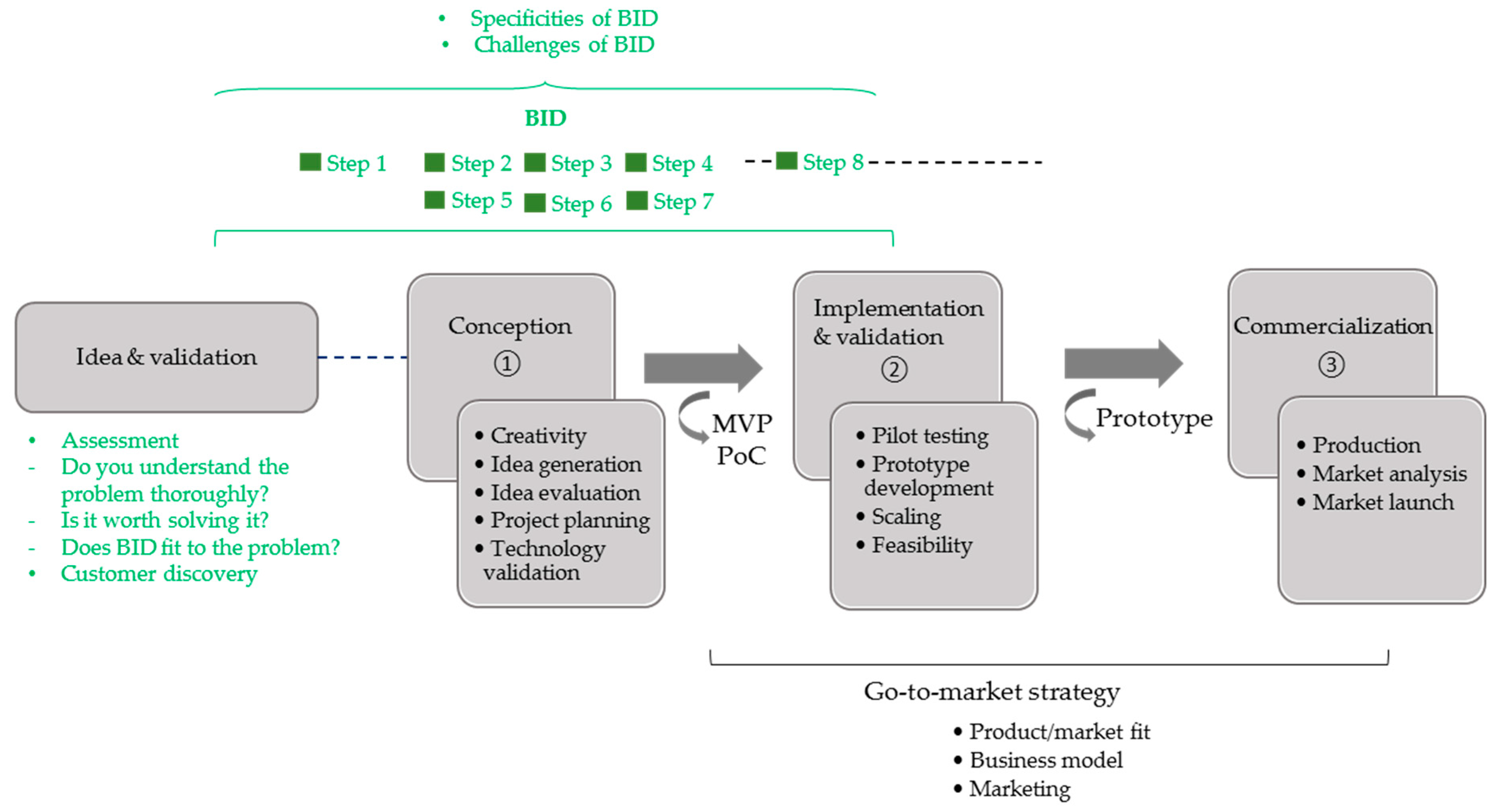
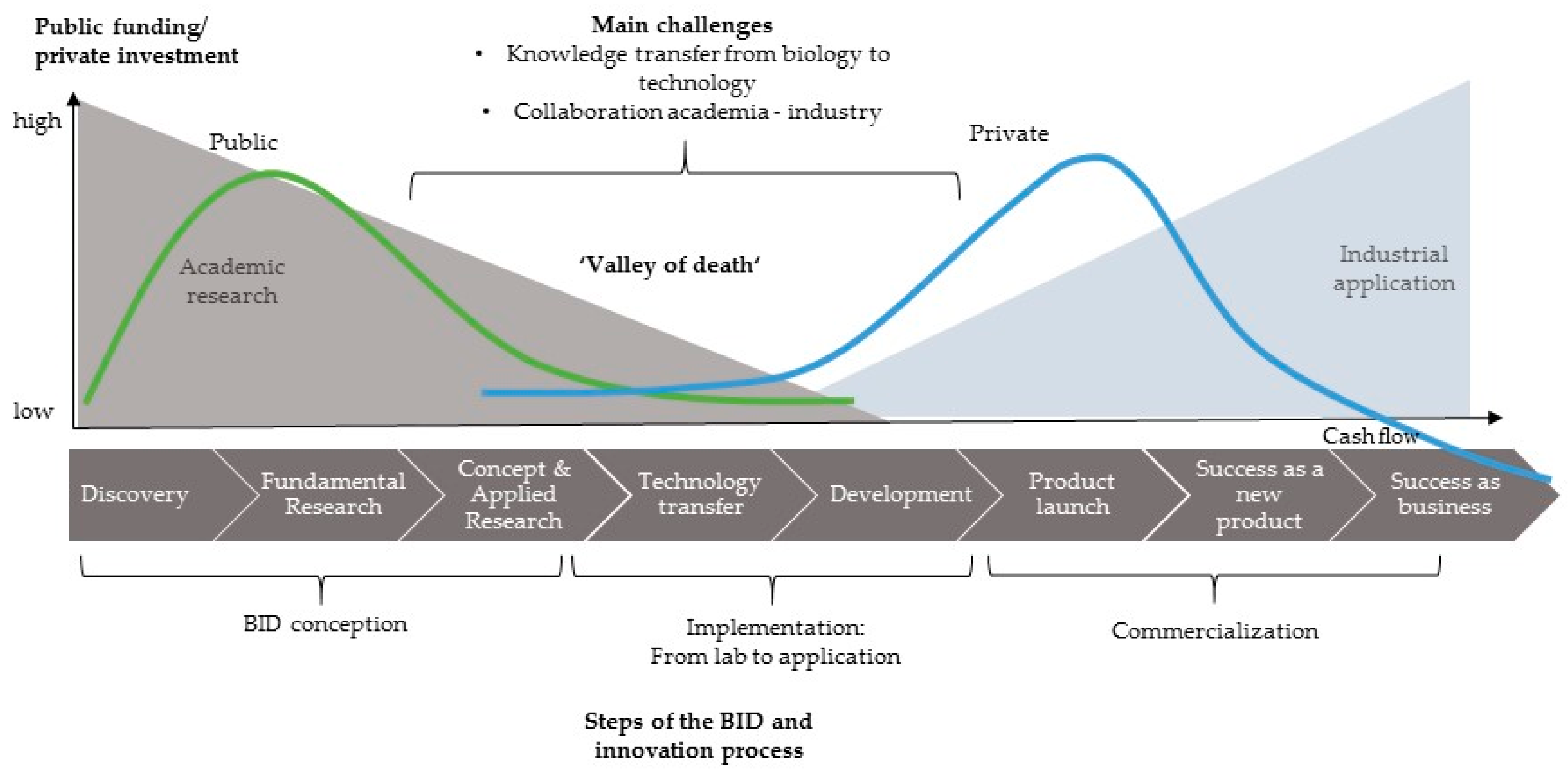
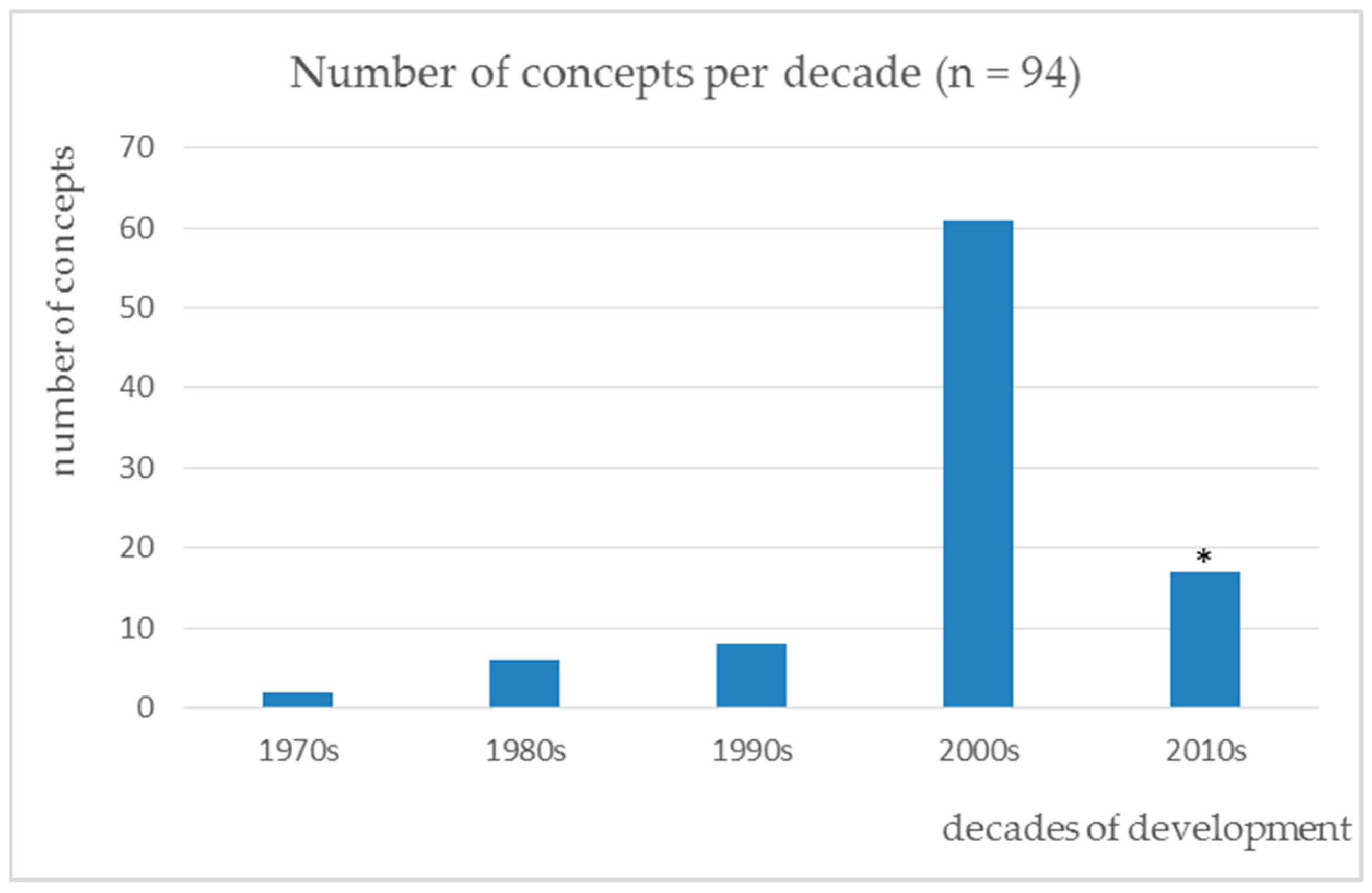
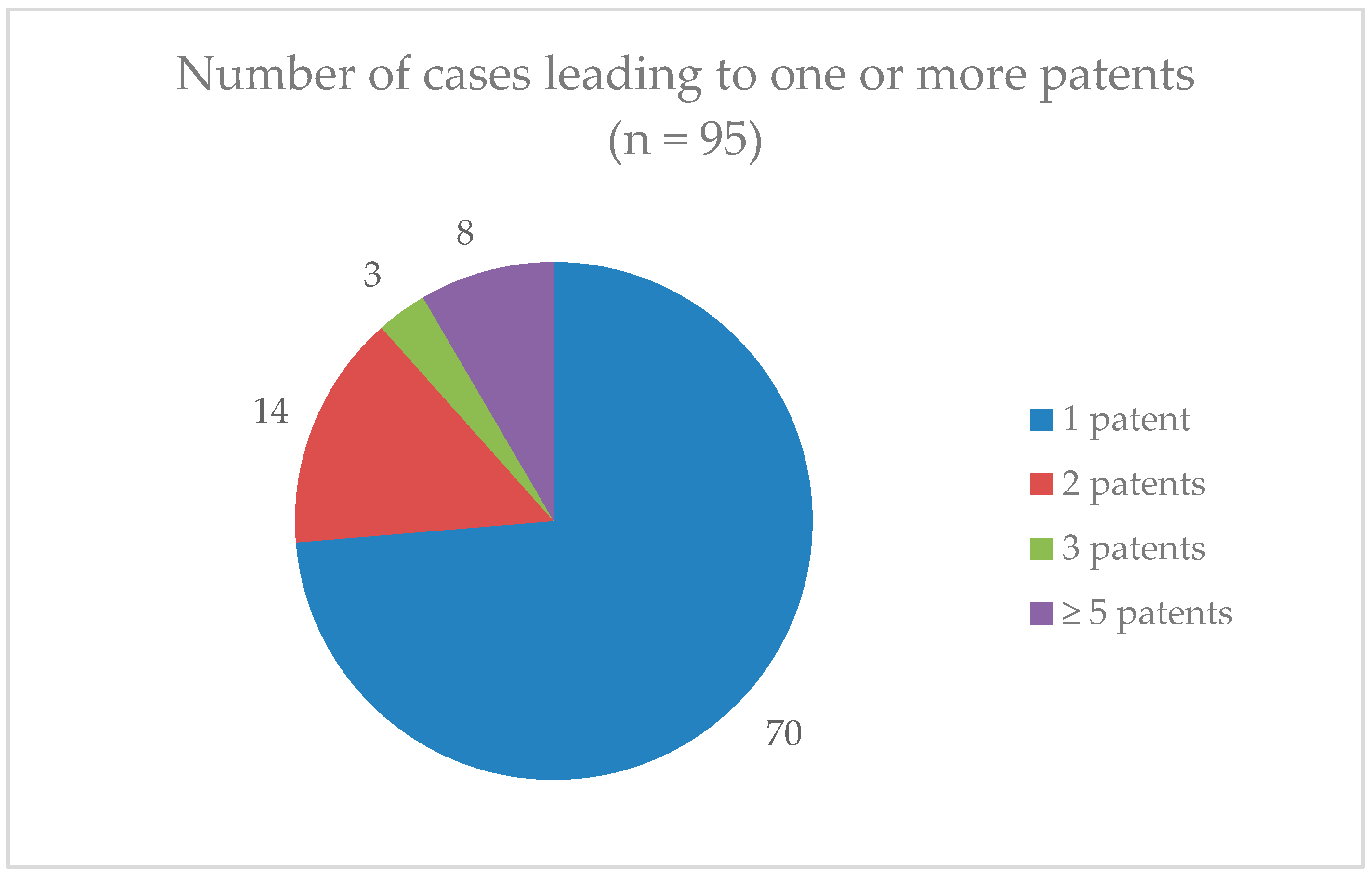
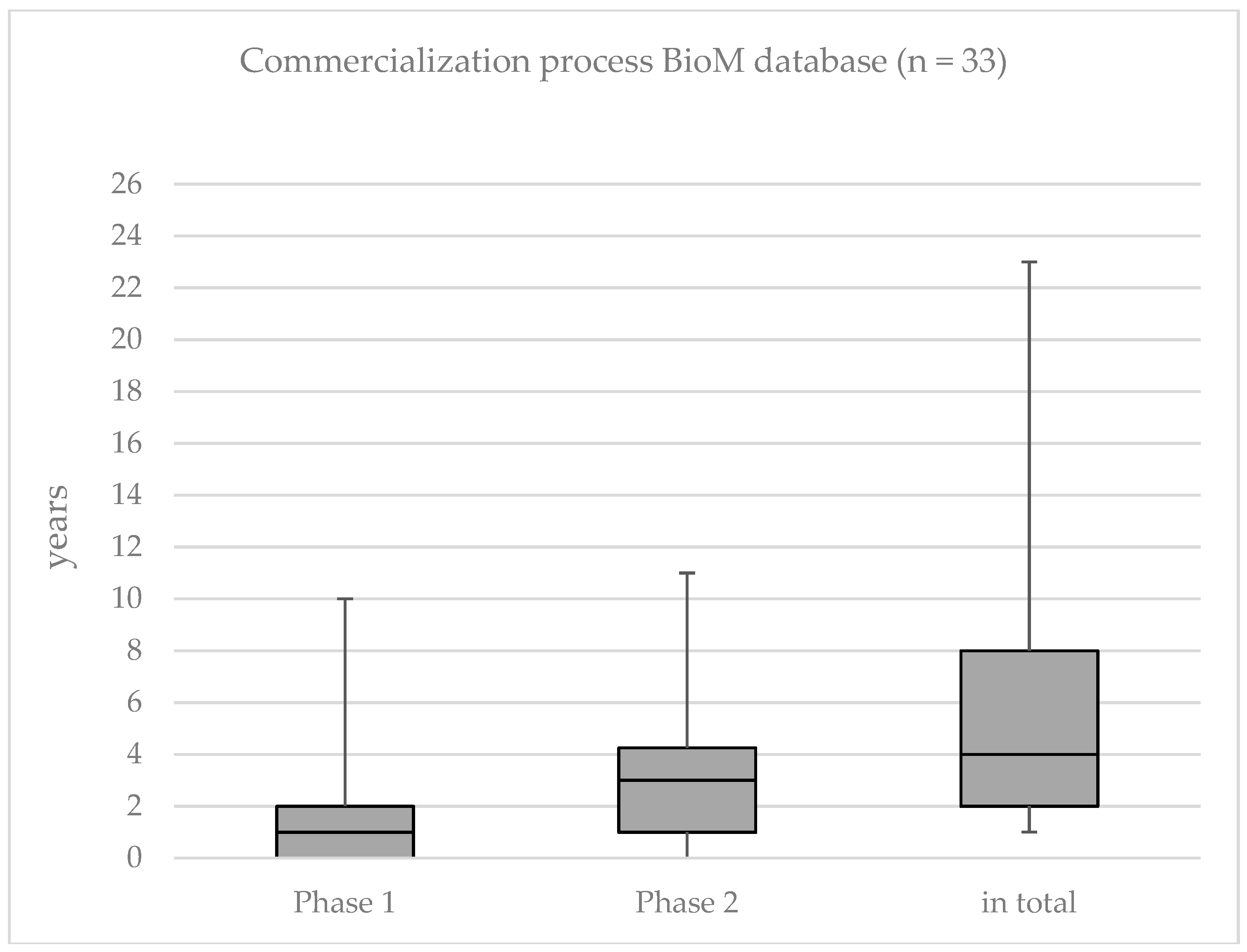
| Level of Invention | Number of Trials | Percentage of Patents |
|---|---|---|
| Apparent: Established solutions; well-known and readily accessible (e.g., reinforcing a wall by making it thicker) | 1–10 | 35 |
| Improvement: Existing system improved, usually with some compromise (e.g., a new electronic device based on already existing components) | 10–100 | 42 |
| Invention within paradigm: A concept for a new generation of an existing system (e.g., automatic transmission) | 100–1000 | 19 |
| Invention outside paradigm: A new concept for performing the primary function of an existing system (e.g., X-ray machine, CD-ROM, RF receiver) | 1000–100,000 | 4 |
| Discovery: Pioneering invention of an essentially new system (e.g. X-rays, laser, radio) | more than 100,000 | 0.3 |
| Process | Number of Cases | Minimum Duration (Years) | Maximum Duration (Years) | Average Duration (Years) |
|---|---|---|---|---|
| Phase 1: concept to prototype | ||||
| problem-driven (Design to Biology) | 16 | same year as concept | 10 | 1.6 |
| solution-based (Biology to Design) | 29 | same year as concept | 10 | 2.1 |
| Phase 2: prototype to commercialization | ||||
| problem-driven (Design to Biology) | 8 | 1 | 11 | 3.3 |
| solution-based (Biology to Design) | 15 | same year as prototype | 11 | 4 |
| Phase: concept to commercialization | ||||
| problem-driven (Design to Biology) | 8 | 1 | 13 | 5.5 |
| solution-based (Biology to Design) | 15 | 1 | 23 | 6.8 |
| Challenges | Effect | Success Factor |
|---|---|---|
| Communication across disciplines | Abandonment Misunderstandings | Constant KTT during project duration; define communication and boundaries |
| Involvement of multiple disciplines, backgrounds, and approaches | Misunderstandings | Turn into a benefit by learning from each other |
| Resistance to ideas | No collaboration possible | Build a network of experts willing to collaborate |
| Duration of development phase | Discouragement | Assess the market properly; ensure the product is scalable |
| Translation between fields | No marketspace | Find a market niche |
| Requirement of proof-of-concept | Discouragement | Determination of channels for production; pursuit of blue ocean strategy; find appropriate methods for validation |
| Duration of commercialization phase | Discouragement | Appropriate marketing, assess the market properly |
| Requirement to design new processes of production | Opportunity for patents; increase of time and costs | Procurement of sufficient funding; patenting |
| Requirement to build up new capacities | Increase of costs | Procurement of sufficient funding |
| Protection with patents | Legal protection for IP | Keep potential competitors out of the market; define IP of various partners |
| Long wait for return on investment | Discouragement | Procurement of sufficient funding |
| Clear research objective and specific goals, mandatory interdisciplinary thinking, open-mindedness, commitment, flexibility, environment for collaboration, willingness to learn from each other, reciprocal respect, endurance, deep understanding of biology, advising experts and impartial referees.1 | ||
© 2019 by the authors. Licensee MDPI, Basel, Switzerland. This article is an open access article distributed under the terms and conditions of the Creative Commons Attribution (CC BY) license (http://creativecommons.org/licenses/by/4.0/).
Share and Cite
Chirazi, J.; Wanieck, K.; Fayemi, P.-E.; Zollfrank, C.; Jacobs, S. What Do We Learn from Good Practices of Biologically Inspired Design in Innovation? Appl. Sci. 2019, 9, 650. https://doi.org/10.3390/app9040650
Chirazi J, Wanieck K, Fayemi P-E, Zollfrank C, Jacobs S. What Do We Learn from Good Practices of Biologically Inspired Design in Innovation? Applied Sciences. 2019; 9(4):650. https://doi.org/10.3390/app9040650
Chicago/Turabian StyleChirazi, Jacques, Kristina Wanieck, Pierre-Emmanuel Fayemi, Cordt Zollfrank, and Shoshanah Jacobs. 2019. "What Do We Learn from Good Practices of Biologically Inspired Design in Innovation?" Applied Sciences 9, no. 4: 650. https://doi.org/10.3390/app9040650
APA StyleChirazi, J., Wanieck, K., Fayemi, P.-E., Zollfrank, C., & Jacobs, S. (2019). What Do We Learn from Good Practices of Biologically Inspired Design in Innovation? Applied Sciences, 9(4), 650. https://doi.org/10.3390/app9040650






